Boston Scientific CRM312004 3120 User Manual prm
Boston Scientific Corporation 3120 prm
Contents
- 1. User Manual
- 2. Users Manual
User Manual
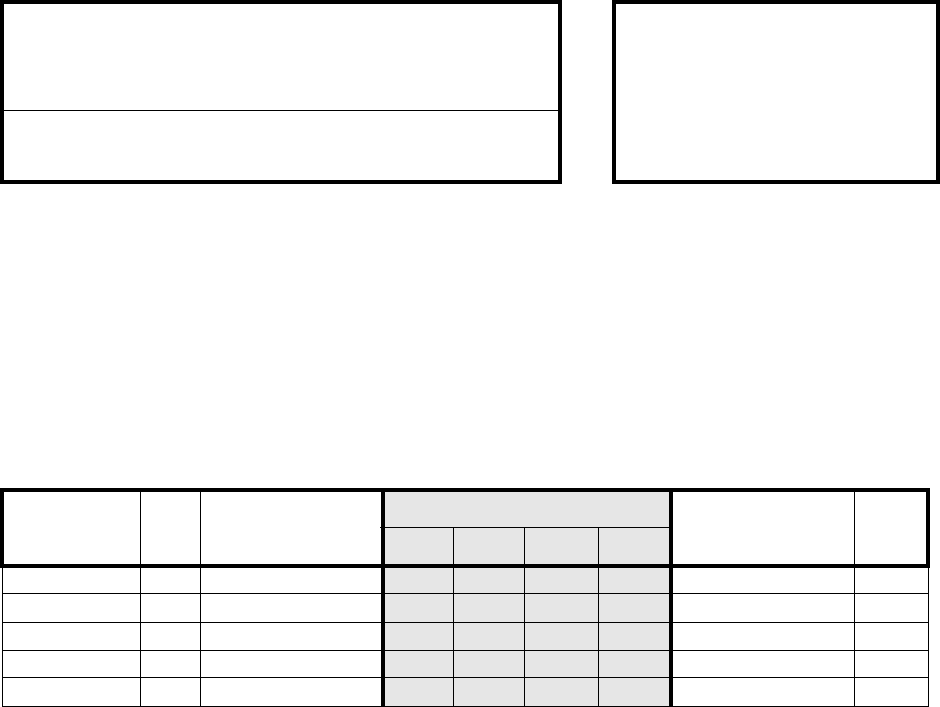
Draft Literature/Labeling Review
002169 Rev B
You are being asked to review product literature/labeling because of your particular expertise. To minimize the number
of review cycles, please review the attached draft thoroughly and provide any comments, changes, or concerns at this
time.
• Please provide any comments on the attached draft by the due date indicated above.
• A non-response will be taken to mean that you accept the draft content "as is."
• Use the grid on the reverse side of this form to help focus your review efforts.
• Your signature is not required.
Note: After receiving comments and making any revisions that are required, Technical Communications will use
Windchill to route a final version of this literature/labeling to obtain required electronic signatures.
We appreciate your efforts and value your feedback. Thank you!
Reason for review / Writer’s comments: Please review the operator’s manual carefully. Pay particular attention
to any content that should not appear in the US manual (OUS manual will be routed later). Note: there is at
least one outstanding issue having to do with the On/Off button and its description. Thanks. WWS
Project: ZOOM LATITUDE operator’s manual
US
Monday, July 26
Date due: Tuesday, July 27
Draft Review
Return to:
Mail Stop:
Department Mail
Stop
Reviewers For Tech Comm Use Only FYI Reviewers
(Return not necessary)
Mail
Stop
Rec’d OK Chgs Trans
Engineering Scott Freeberg
Regulatory Karen Alsop
Tech Comm Nathan Quanbeck
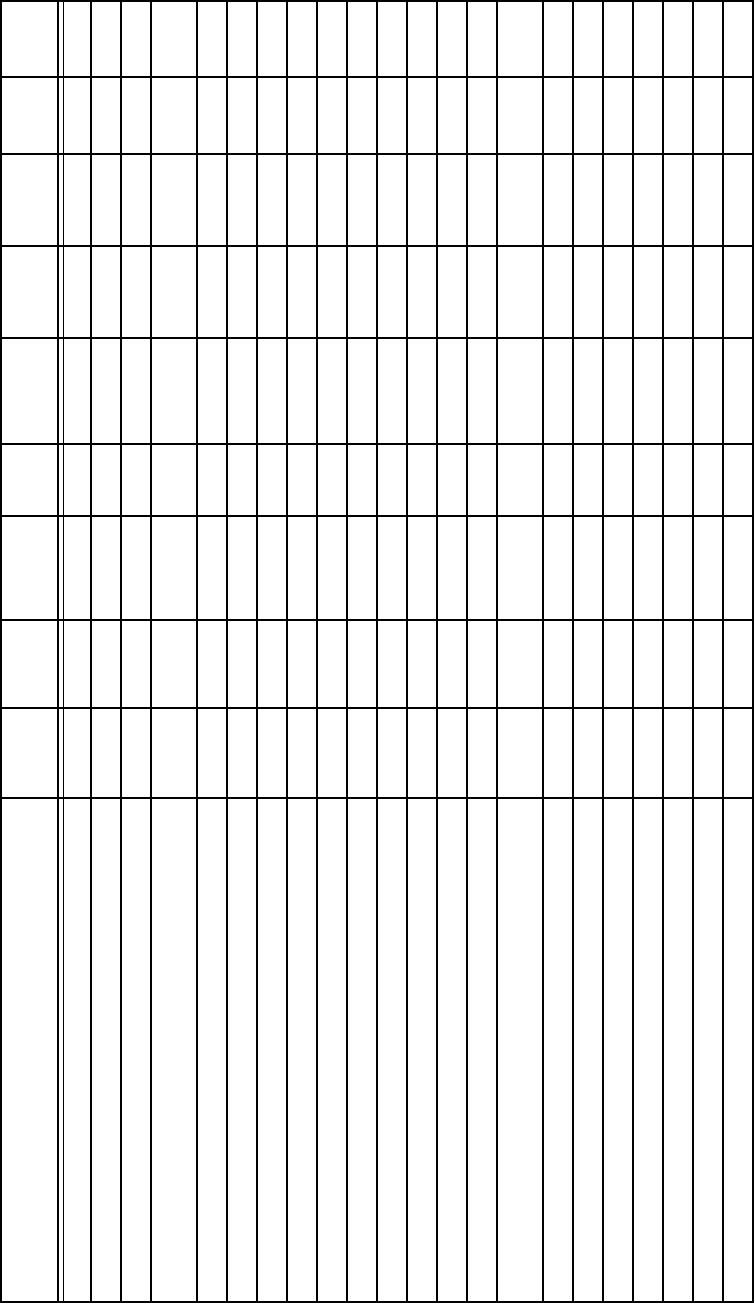
Instructions For Review
The table below was designed to help streamline the literature review process, to reduce the number of reviews per piece of literature, to reduce the amount of time you need
to spend reviewing each piece, and to help you focus your attention while reviewing literature.
Suggested Areas of Focus Clinicals Tech
Comm
Design
Engineer Legal Marketing Package
Design
Project
Manager Reg FCE
Verify against clinical protocol X X X
Product description, product handling (sterilization, shipping, storage) X X
Product specifications, units of measure (in tables and throughout text) X X
Product features—appropriate features highlighted? described correctly? any
features overlooked? XXXX XX
Illustrations appropriate to corresponding text and labeled correctly? X X X X X
Tables and text relating to parameters, tolerances, product functions correct? X X X
Review cautions and notes—appropriate? necessary? any missing? X X X X X X
Implant procedures correct? X X X
Equipment hook-up procedures, lead-to-PG connections, etc. X X X X
Are references to other Guidant products still correct and relevant? X X X X X
Is info in this literature consistent with other related literature (leads, pg)? X X X X X X
References to other products affect other submissions? X X X X
Liability issues based on claims made in literature X X X
Warranty information correct? XX
Has any information that should be included been overlooked (features,
specs, government requirements, legal requirements)? XX XXX X XXX
List of items packaged with product (is the list correct? anything missing?) X X X
Does the piece of literature match the documentation specs? correct size? X X X
Verify part number of literature. Labels: appropriate mfg codes, ACNs, etc. X X
Verify copyright and trademark notations X X X
Adherence to literature/communications standards X
Punctuation, consistency in treatment of product names, parameter, etc. X
Guidant address, phone numbers, warranty layout formats correct? X

Operator’s Manual
ZOOM® LATITUDE™
Programming
System
MODEL 3120 PRM
RESTRICTED DEVICE: Federal law (USA) restricts
the sale, distribution, or use of this device to, by, or
on the lawful order of a physician.
CONTENTS
DESCRIPTION AND USE . . . . . . . . . . . . . . . . . . . . . . . . . . . . 3
Intended Use . . . . . . . . . . . . . . . . . . . . . . . . . . . . . . . . . . . 3
Contraindications . . . . . . . . . . . . . . . . . . . . . . . . . . . . . . . . 3
Precautions . . . . . . . . . . . . . . . . . . . . . . . . . . . . . . . . . . . . . 3
Adverse Effects . . . . . . . . . . . . . . . . . . . . . . . . . . . . . . . . . 4
SYSTEM FEATURES . . . . . . . . . . . . . . . . . . . . . . . . . . . . . . . . 4
System Accessories . . . . . . . . . . . . . . . . . . . . . . . . . . . . . . 5
Optional External Printer . . . . . . . . . . . . . . . . . . . . . . . . . . 5
Optional External Monitor . . . . . . . . . . . . . . . . . . . . . . . . . . 5
PREPARING THE PRM FOR USE . . . . . . . . . . . . . . . . . . . . . . 6
Prepare the Telemetry Wand . . . . . . . . . . . . . . . . . . . . . . . 6
Make External Cable Connections . . . . . . . . . . . . . . . . . . . 7
Start the PRM . . . . . . . . . . . . . . . . . . . . . . . . . . . . . . . . . . . 8
USING THE PRM . . . . . . . . . . . . . . . . . . . . . . . . . . . . . . . . . . . 8
Startup Screen . . . . . . . . . . . . . . . . . . . . . . . . . . . . . . . . . . 8
Touchscreen . . . . . . . . . . . . . . . . . . . . . . . . . . . . . . . . . . . . 9
Indicator lights . . . . . . . . . . . . . . . . . . . . . . . . . . . . . . . . . . 9
ECG Display . . . . . . . . . . . . . . . . . . . . . . . . . . . . . . . . . . . 10
Keys . . . . . . . . . . . . . . . . . . . . . . . . . . . . . . . . . . . . . . . . . 11
Monitoring/Recording Functions . . . . . . . . . . . . . . . . . . . . 12
Using an External Recorder . . . . . . . . . . . . . . . . . . . . . . . 13
Using an External Printer . . . . . . . . . . . . . . . . . . . . . . . . . 13
Quick Start . . . . . . . . . . . . . . . . . . . . . . . . . . . . . . . . . . . . 13
The Utilities Menu on the Startup Screen . . . . . . . . . . . . . 14
The Select PG Option on the Startup Screen . . . . . . . . . . 15
Changing Parameter Values . . . . . . . . . . . . . . . . . . . . . . 16
MAINTENANCE AND HANDLING . . . . . . . . . . . . . . . . . . . . . 17
Loading the Paper . . . . . . . . . . . . . . . . . . . . . . . . . . . . . . 17
Thermal Paper Storage . . . . . . . . . . . . . . . . . . . . . . . . . . 18
Cleaning the PRM . . . . . . . . . . . . . . . . . . . . . . . . . . . . . . 18
Patient Data Disk . . . . . . . . . . . . . . . . . . . . . . . . . . . . . . . 19
Operation and Storage Conditions . . . . . . . . . . . . . . . . . . 20
PRM Storage . . . . . . . . . . . . . . . . . . . . . . . . . . . . . . . . . . 21
EXTERNAL CABLE CONNECTIONS . . . . . . . . . . . . . . . . . . . 22
Surface ECG Connections . . . . . . . . . . . . . . . . . . . . . . . . 23
Patient–Recorder–PRM Connection . . . . . . . . . . . . . . . . 24
Patient–PRM–Recorder Connection . . . . . . . . . . . . . . . . 25
Parallel Connection . . . . . . . . . . . . . . . . . . . . . . . . . . . . . 26
TROUBLESHOOTING . . . . . . . . . . . . . . . . . . . . . . . . . . . . . . 27
LABEL SYMBOLS . . . . . . . . . . . . . . . . . . . . . . . . . . . . . . . . . 29
WARRANTY INFORMATION . . . . . . . . . . . . . . . . . . . . . . . . . 32
ORDERING ACCESSORIES . . . . . . . . . . . . . . . . . . . . . . . . . 32
SERVICE . . . . . . . . . . . . . . . . . . . . . . . . . . . . . . . . . . . . . . . . 32
PREVENTIVE MAINTENANCE . . . . . . . . . . . . . . . . . . . . . . . 32
ENVIRONMENTAL PROTECTION . . . . . . . . . . . . . . . . . . . . . 32
SPECIFICATIONS (Nominal) . . . . . . . . . . . . . . . . . . . . . . . . . 33
3
DESCRIPTION AND USE
The ZOOM® LATITUDE™ Programming System, which includes the
Model 3120 Programmer/Recorder/Monitor (PRM), is a portable cardiac
rhythm management system designed to be used with Guidant implant-
able pulse generators.
For programming instructions, refer to the System Guide for the Guidant
pulse generator being interrogated.
Intended Use
The Model 3120 PRM is intended to be used as a complete system to
communicate with Guidant implantable pulse generators.
The software in use controls all communication functions for the pulse
generator. For detailed software application instructions, refer to the Sys-
tem Guide for the Guidant pulse generator being interrogated.
Contraindications
For contraindications for use, refer to the System Guide for the Guidant
pulse generator being interrograted.
The Model 3120 PRM is contraindicated for use with any pulse generator
other than a Guidant device.
Precautions
General
• Use the appropriate Guidant programmers equipped with the appro-
priate software to program Guidant pulse generators.
• The Model 3120 PRM is designed to be used only with the
Model 6577 Sterilizable Telemetry Wand. Do not use the Model 6575
Telemetry Wand with the Model 3120 PRM.
• Use only the supplied stylus with the Model 3120 PRM; the use of any
other object could damage the touchscreen.
NOTE: Use of the stylus is recommended for accuracy; however, touch-
ing an item on the screen with your finger will also activate a selection.
Preparation for Use
• Remove the telemetry wand from all packaging material before steril-
izing it.
• Avoid establishing telemetry communication between the PRM and
the pulse generator when the PRM is in close proximity to monitors,
high-frequency electrosurgical equipment, and strong magnetic fields,
such as magnetic resonance imaging (MRI) devices. The telemetry
link may be impaired and, in the case of MRI, may interfere with the
PRM.
Maintenance and Handling
• Do not use an abrasive cloth or volatile solvents to clean any portion
of the PRM.
4
• Keep disks away from magnets and magnetized objects, including
telephones, power-supply adapters, and monitors.
• Do not place a magnet on the PRM.
• The PRM is not water-proof or explosion-proof. It should not be used
in the presence of flammable gas mixtures including anesthetic mix-
ture with air, oxygen, or nitrous oxide.
Adverse Effects
None known.
SYSTEM FEATURES
The PRM communicates with Guidant pulse generators via telemetry us-
ing the Guidant Model 6577 Sterilizable Telemetry Wand to perform the
following functions:
• Interrogates the programmable pulse generator.
• Programs detection and therapy parameters for an implantable
Guidant pulse generator.
• Displays, records, and stores patient data and allows the physician to
evaluate alternative prescription modes.
• Stores patient data that can be recalled later in the patient session for
analysis. (For certain applications only)
• Stores patient data on a disk that can be accessed at later sessions.
• Generates printed reports that detail pulse generator functions, stored
patient data, and test results.
• Allows the physician to perform tests in an electrophysiology (EP) lab-
oratory, in an operating room, in an emergency room, or at a patient’s
bedside.
In addition, the PRM has the following capabilities:
• Provides a direct interface between an external stimulator and an im-
planted Guidant pulse generator for programmed electrical stimula-
tion (PES) during EP studies.
• Provides use without device telemetry as an electrocardiogram (ECG)
display and recorder for patient diagnosis.
• Simultaneously prints real-time surface ECG and telemetered signals
(intracardiac electrograms and event markers) via the internal printer/
recorder.
The PRM is equipped with the following features:
• PRM function keys, including PROGRAM, STAT PACE,
STAT SHOCK, DIVERT THERAPY, and INTERROGATE.
• Printer/recorder function keys, including paper speed, calibrate, zero
to baseline, and paper feed.
• Touchscreen with tethered stylus.
5
• Color display screen.
• One floppy disk drive.
• Internal hard drive.
• High-speed four-inch (110 cm) thermal printer/recorder.
• Connections for slaved stimulation via an external signal source.
• Connection for recording data on an external FM tape recorder or strip
chart recorder or both.
• Connection for an optional external printer.
• USB port for software installation by Guidant personnel.
System Accessories
The ZOOM LATITUDE programming system consists of the Model 3120
PRM and the following accessories:
• Model 2902 AC Power Cord
• Model 6577 Sterilizable Telemetry Wand
• Model 6627 Patient Data Disks (10)
• Model 6750 Surface ECG Patient Cable
• Model 6979 Printer Paper (4)
• Antenna
Other accessories for use with the PRM that can be ordered from Guidant
include the following:
• Model 6809 Accessory Kit
• Model 6892 Controller-Stimulator Cable
• Model 6750 Surface ECG Patient Cable
• Model 6924 External Recorder Cable
• Model 6629 ECG-BNC Slave Cable
• Model 6930 Stimulation Input Cable Adapters
• Model 6934 Phono-BNC Adapters
• Model 6977 VGA Extension Cable
Optional External Printer
The use of an external printer is optional. Only compatible external print-
ers that have been tested and qualified for use should be used with the
Model 3120 PRM. Contact your Guidant sales representative to deter-
mine which printer(s) can be used.
CAUTION: Although the external printer meets leakage-current require-
ments for commercial products, it may not meet the reduced leakage
requirements for medical products. Consequently, the external print-
er must be kept outside the patient environment (at least 1.5 meters
away from the patient).
Optional External Monitor
The use of an external monitor is optional. Contact your Guidant sales
representative to determine which monitor(s) can be used.
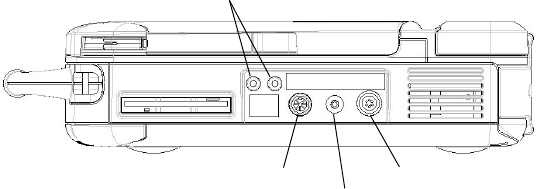
6
CAUTION: Although the external monitor meets leakage-current require-
ments for commercial products, it may not meet the reduced leakage
requirements for medical products. Consequently, the external mon-
itor must be kept outside the patient environment (at least 1.5 meters
away from the patient).
PREPARING THE PRM FOR USE
Prepare the Telemetry Wand
1. If the telemetry wand is to be used in a sterile field when using the
PRM, it first must be sterilized with ethylene oxide or steam. To
sterilize it, follow the instructions in the product literature for the
wand.
CAUTION: Remove the telemetry wand from all packaging material be-
fore sterilizing it.
2. Plug the telemetry wand into the connector on the right side of the
PRM (Figure 1).
Figure 1. Right side panel of the PRM.
CAUTION: Avoid establishing telemetry communication between the
PRM and the pulse generator when the PRM is in close proximity to
monitors, high-frequency electrosurgical equipment, and strong
magnetic fields, such as MRI devices. The telemetry link may be im-
paired and, in the case of MRI, may interfere with the PRM.
This device complies with Part 15 of the Federal Communications Com-
mission (FCC) rules. Operation is subject to the following two conditions:
1. This device may not cause harmful interference, and
2. This device must accept any interference received, including interfer-
ence that may cause undesired operation.
CAUTION: Changes or modifications not expressly approved by Guidant
could void the user’s authority to operate the equipment.
ECG Connector
Telemetry Wand Connector
Analog Output Channel
Stimulator Inputs

7
Make External Cable Connections
1. Connect the Model 6750 Surface ECG Patient Cable to the ECG
connector on the right side of the PRM (Figure 1). This patient con-
nection is electrically isolated. Attach the surface electrodes to the
patient in a standard three-wire or five-wire configuration.
NOTES:
• If the PRM is in close proximity to high-frequency electrosurgical
equipment, the surface ECG traces may exhibit noise interference.
Refer to the troubleshooting section for corrective action.
• The ECG subsystem may be sensitive to ambient noise when the
ECG inputs are not terminated.
2. Connect the Model 6924 External Recorder Cable to the analog out-
put channel on the right side of the PRM (Figure 1). Connect the oth-
er end to the multichannel recorder or external strip chart recorder.
The Model 3120 PRM has high-level analog outputs.
3. Connect the Model 6892 Controller-Stimulator Cable to the pacing
stimulation source connector marked “Stimulator Input” on the right
side of the PRM (Figure 1) and then into the corresponding terminal
on the electrical stimulation source.
4. (Optional) Connect the external printer to the PRM using the parallel
cable provided with the printer (Figure 2). The external printer must
be connected and activated to allow external reports to be printed.
5. (Optional) Connect the external monitor to the PRM using a standard
VGA cable (Figure 2). The Model 6977 VGA Extension Cable is
available from Guidant as an accessory.
Figure 2. Left side panel of the PRM.
Power Button
External VGA Monitor Connector
External Printer Connector
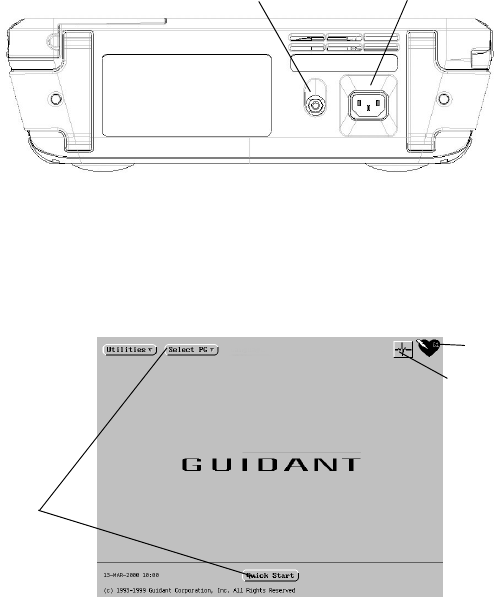
8
Start the PRM
Perform the following steps to start the PRM:
1. Connect the power cord into the AC connector on the rear panel
(Figure 3).
2. Plug the power cord into the appropriate AC outlet.
Figure 3. Rear panel of the PRM.
3. Raise the screen to a comfortable viewing angle.
4. Press the Power button (Figure 2).
5. Wait for the Guidant startup screen (Figure 4) to appear.
Figure 4. The startup screen is displayed when the programmer is powered
On.
USING THE PRM
Startup Screen
The startup screen (Figure 4) displays the following information:
• The Utilities button allows access to programmer information and set-
up functions prior to accessing the application software.
Grounding Connector AC Connector
Buttons
Heart-rate
Indicator
ECG Icon

9
• The Select PG button allows the desired application to be chosen and
started.
• The ECG icon changes the screen display to an ECG display avail-
able for patient diagnosis.
• The heart-rate indicator displays the intrinsic ventricular rate of the pa-
tient.
•The Quick Start
® button is an automated method for starting the ap-
propriate application.
• The bottom left corner of the screen displays the date, time, and pro-
grammer information.
Touchscreen
The Model 3120 PRM has a touchscreen. You can select a button or icon
on the touchscreen by touching the desired item with the stylus attached
to the PRM and lifting the stylus from the screen. Only one button or icon
may be selected at a time. Menu and parameter selection buttons will ac-
tivate when selected; the buttons in the parameter value palettes will ac-
tivate when the stylus is lifted from the screen. To move from one screen
to another, select the navigation buttons at the bottom of the screen.
CAUTION: Use the supplied stylus with the Model 3120 PRM; the use of
any other object could damage the touchscreen.
NOTE: Use of the stylus is recommended for accuracy; however, touch-
ing an item on the screen with your finger will also select that item.
Indicator lights
The Model 3120 PRM has three indicator lights on the upper left corner,
above the screen:
NOTE: ZIP telemetry is a wandless, two-way radio frequency (RF) com-
munication option that allows the PRM system to communicate with the
pulse generator.
Symbol Indicator light Function
For future use. For future use.
Inductive telemetry
Lit when inductive, wanded telemetry has
been established and interrogation or
programming is occurring
On Lit when the PRM is On.
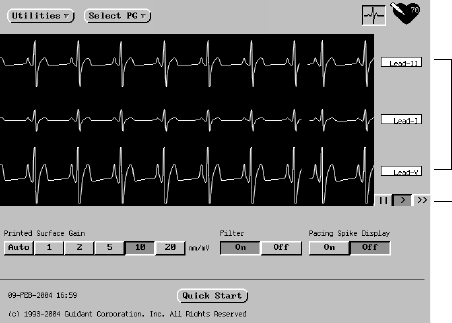
10
ECG Display
To display surface ECG signals on the PRM without device interrogation,
select the ECG icon on the startup screen (Figure 5). Connect the patient
leads; for instructions on proper patient cable connections, refer to “EX-
TERNAL CABLE CONNECTIONS” on page 22. The PRM can display
three surface traces of up to six limb leads or one chest lead. The top dis-
played lead will be annotated with the pacing spike marker if that feature
is selected. To display the pacing spike markers correctly, the Lead II
electrodes must be connected to the patient regardless of which lead is
displayed. The heart-rate indicator in the upper-right corner of the startup
screen will display the intrinsic ventricular rate as the trace runs.
Figure 5. The ECG screen, as accessed from the startup screen.
The following screen buttons can be used to change the values and ap-
pearance of the traces:
•Lead Selection Buttons—Select the lead traces to be displayed.
•Speed Buttons—Select the desired speed button on the ECG
display: Pause (||) (to freeze the trace), Play (>), or Fast-Forward (>>).
•Printed Surface Gain—Select the appropriate value to adjust the
surface gain of the traces that are captured on printouts.
•Filter—Select On to minimize noise on the surface ECG.
•Pacing Spike Display—Select On to show detected pacing spikes,
annotated by a marker on the top waveform.
NOTE: The values as set up on the startup screen will be the defaults
used for the application traces. The corresponding values can be
changed from the Trace Selections screen while in the application. For
detailed application programming instructions, refer to the System Guide
for the Guidant pulse generator being interrogated.
Speed Buttons
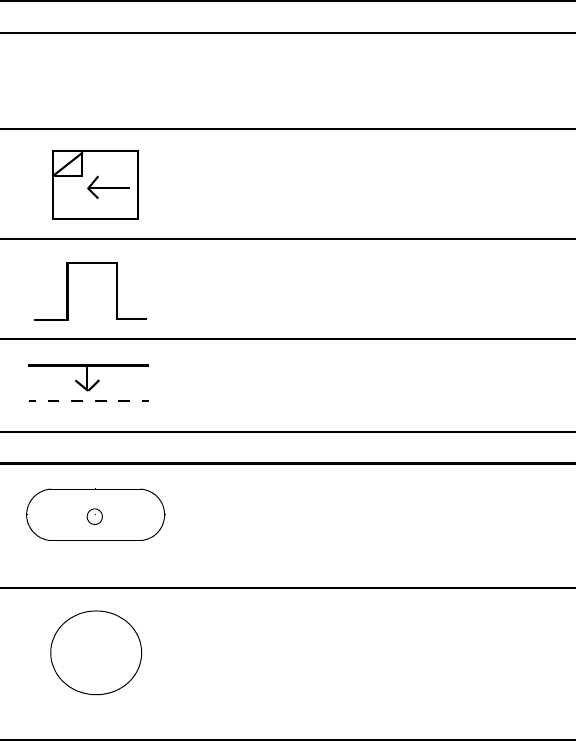
11
Keys
For specific instructions on how to operate the PRM keys and use the te-
lemetry wand, refer to the System Guide for the Guidant pulse generator
being interrogated. General key functions are summarized below.The key
pad on the right side of the PRM is shown in Figure 6.
Table 1 Key Functions
Left side of key pad:
0 (stop), 10, 25, 50,
and 100 mm/sec
(paper-speed keys)
Press the speed keys to specify the paper speed for
the internal printer/recorder. The printout will show
the date and time, lead(s) being printed, gain setting,
chart speed, and filter setting. To stop the printer/
recorder, press the speed key labeled “0” (zero).
Press the paper-feed key to scroll the printer paper
on the internal printer/recorder.
Press this key to cause the internal printer/recorder
to print a one-mV calibration pulse.
Press this key to force the trace back to the baseline
after a defibrillation shock.
Right side of key pad
Press STAT PACE when in telemetry communication
with the pulse generator to program predetermined
parameters for emergency bradycardia pacing
Press DIVERT THERAPY when in telemetry
communication with the pulse generator to divert
tachycardia therapy delivery.
STAT PACE
DIVERT THERAPY
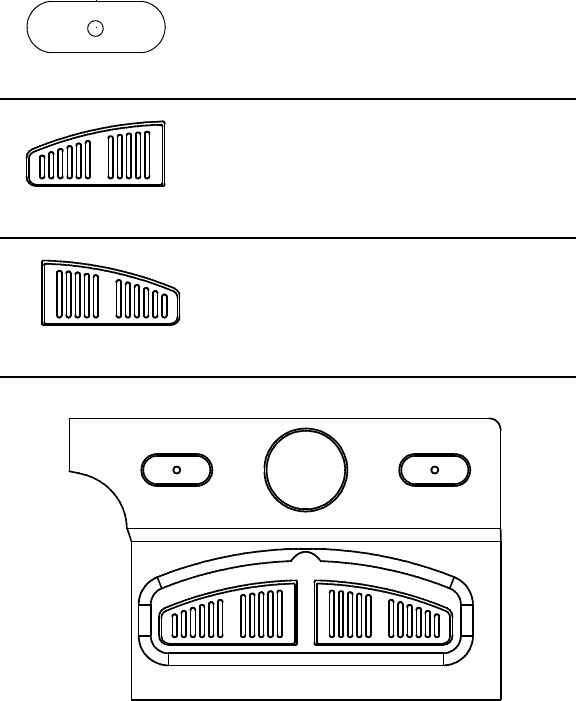
12
Figure 6. Model 3120 PRM right-side keypad.
Monitoring/Recording Functions
Surface ECG
Pressing any speed key will run a surface ECG if the surface ECG patient
cable is connected to the PRM and electrodes are attached to the patient
(unless a report is being printed). For detailed instructions, refer to “ECG
Display” on page 10.
Press STAT SHOCK when in telemetry
communication with the pulse generatorto program
predetermined high-energy parameters for
emergency shock delivery.
Press PROGRAM when in telemetry communication
with the pulse generator to transmit new parameter
values to the pulse generator.
Press INTERROGATE when in telemetry
communication with the pulse generator to obtain
information stored in the pulse generator’s memory.
Table 1 Key Functions
STAT SHOCK
PROGRAM
INTERROGATE
STAT PACE STAT SHOCK
DIVERT THERAPY
PROGRAM INTERROGATE
13
Intracardiac Electrogram
Intracardiac electrograms may be printed or displayed and event markers
may be printed by the PRM. For detailed instructions, refer to the System
Guide for the Guidant pulse generator being interrogated.
Using an External Recorder
To view the surface ECG traces on an external recorder, press the de-
sired speed key on the external printer/recorder while the traces are dis-
played on the PRM screen. See “EXTERNAL CABLE CONNECTIONS”
on page 22 for instructions on connecting the PRM to the external record-
er. Refer to the external recorder manual for instructions specific to its op-
eration.
Using an External Printer
If supported by the software application currently running, an optional ex-
ternal printer can be used. To print reports to an external printer, first con-
nect the printer to the Model 3120 PRM using the parallel cable. The ca-
ble connects the external printer to the PRM via the external printer con-
nector (Figure 2). The external printer must be connected and activated
to allow external reports to be printed. For more information, see “Optional
External Printer” on page 5.
Equipment connected to the external connections must comply with the
respective IEC standards (e.g. IEC 950 for data processing equipment
and IEC 601-1 for medical equipment). Furthermore all configurations
shall comply with the system standard IEC 601-1-1. Everybody who con-
nects additional equipment to the signal input part or signal output part
configures a medical system, and is therefore responsible that the system
complies with the requirements of the system standard IEC 601-1-1. If in
doubt, Guidant Technical Services department or your local Guidant Rep-
resentative.
Quick Start
The Quick Start button is used to automatically identify and interrogate the
implanted pulse generator. Place the telemetry wand over the pulse gen-
erator, and select the Quick Start button. A message window will appear,
indicating one of the following conditions, based on the implanted device:
•Application Startup in Progress—If the software for the implanted
device is installed on the PRM, the PRM will identify the device, open
the correct application, and automatically interrogate the pulse gener-
ator.
•Software not installed—If the software application for the implanted
device is available for the PRM but not installed on it, a message win-
dow will appear, identifying the device and stating that the software is
not installed on the PRM.
•Software not available on PRM—If an older model of Guidant device
is identified, a message window will appear, informing the user that he
or she must use a Model 2035 or 2901 programmer to interrogate and/
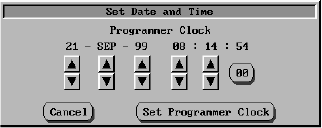
14
or program the device. The model number of the software module or
application will also be identified.
•PG not identified—If a non-Guidant or one of certain older models of
Guidant pulse generators is implanted, a message window will ap-
pear, notifying the user that the wand is out of range, telemetry noise
is present, or the device is not identified.
To access the demonstration (DEMO) mode (or the Read Disk feature,
which is available in some applications), use the Select PG button at the
top of the screen to choose the pulse generator family instead of using the
Quick Start button.
The Utilities Menu on the Startup Screen
If desired, before accessing the pulse generator software application, the
version numbers of the system software and software applications can be
displayed, the programmer clock can be modified, the institution name
can be changed, and data disks can be copied and formatted. (To access
the startup screen from within a software application, select the Quit op-
tion from the Utilities button to exit the software application and return to
the startup screen.)
1. On the startup screen, select the Utilities button.
2. Select the About option to view the version numbers of the system
software and application software residing on the programmer.
3. Select the Set Programmer Clock option to change the programmer
date and time (24-hour clock), which is displayed in the lower left cor-
ner of the startup screen. The Set Date and Time window will appear
(Figure 7).
a. Change the values by selecting an up or down arrow.
b. To reset the seconds display to zero, select the box containing
two digits (shown as 00 in Figure 7).
c. When the desired values are displayed, select the Set Program-
mer Clock button to confirm the new date and time. (To cancel any
changes prior to confirming the new values, select the Cancel but-
ton; the window will close without changing the values.)
Figure 7 The Set Date and Time window.
15
NOTE: The programmer and pulse generator clocks may be synchro-
nized once the application is accessed. Refer to the “Set Clock” section in
the System Guide for the Guidant pulse generator being interrograted.
4. Select the About option to update the institution name. If the pro-
grammer has been moved to a different institution, the name of the
institution as it appears on the startup screen can be changed. For
instructions on entering new data, refer to “Changing Parameter Val-
ues” on page 16.
NOTE: The institution name also is displayed in the heading of printed
reports.
5. Select the Format Disk option to erase all data from a Model 6627
Patient Data Disk and reformat it so new data can be saved on the
disk. Follow the directions displayed in the message windows.
6. Select the Copy Disk option to copy patient data from one disk (the
source disk) to another (the destination disk). Do not use a destina-
tion disk that contains patient data, because the existing data will be
lost. Follow the directions displayed in the message windows. (This
function performs in the same manner as the Copy Disk function of
the software application; refer to the “Utilities Button on the Main Ap-
plication Screen” section of the System Guide for the Guidant device
being interrogated.
The Select PG Option on the Startup Screen
This option allows the software application to be selected manually. Use
this option to access the DEMO mode (or the Read Disk feature, which is
available in some applications). (You can also use this option to interro-
gate a pulse generator, but you may find it more convenient to use the
Quick Start feature described earlier in this manual.)
1. To access the desired software application without using the Quick
Start feature, select the Select PG button.
2. The names of the available software applications will appear. Select
the applicable software application. Each application communicates
with its pulse-generator family.
3. A screen will appear with options to interrogate the pulse generator
or use the DEMO mode. (Some applications will also display the op-
tion to read a patient data disk).
4. To become familiar with the software without interrogating a pulse
generator, select the DEMO button; the main application screen will
be displayed and the DEMO logo will appear at the top of the screen.
The screens displayed during the DEMO mode reflect the software
application family’s device features and programmable values.
NOTE: STAT PACE, STAT SHOCK, and DIVERT THERAPY commands
are functional in DEMO mode only if the telemetry wand is positioned over
the pulse generator.
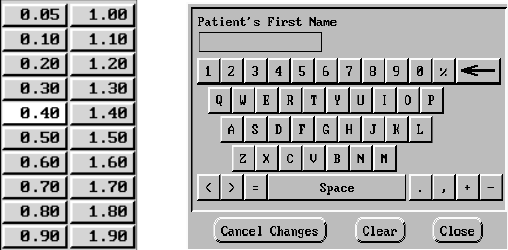
16
5. To exit the DEMO mode, depending on which application you are us-
ing, select the New Patient or Quit options from either the Utilities but-
ton or the Exit button. For more information about these options, refer
to the System Guide for the Guidant pulse generator being interro-
gated.
6. To proceed with an interrogation session or read data from a patient
data disk (which is a feature that is available in some applications),
refer to the System Guide for the Guidant pulse generator being in-
terrogated.
Changing Parameter Values
The screens for many of the features contain parameter information, in-
cluding parameter names, values for the present parameter settings, val-
ue boxes to accommodate value changes, and buttons to cancel chang-
es. Many screens display two columns next to the parameter names: the
Present column and the Change column. The Present column displays
the currently programmed value for each parameter, and the Change col-
umn displays value boxes that allow the clinician to make changes to the
parameters. If a particular parameter is not applicable in the current
mode, dashes will be displayed in the Present column. If a particular pa-
rameter is not applicable to the mode in the Change column, that param-
eter’s value box is not displayed.
Palette Window: To change the parameter values, first select the appro-
priate parameter’s value box in the Change column. A palette window will
appear (as shown in Figure 8). Select a value from the palette window (by
touching the desired value and lifting the stylus from the screen). Touch-
ing the screen outside a window will close it without making a selection.
When changes have been made to parameter values, the data appear in
the Change box until programmed into the pulse generator.
Figure 8 Types of windows enabling value changes.
Palette Window Keyboard Window
17
In some screens (e.g., Patient Data screens), data are not displayed in
Present and Change columns. These screens display value boxes that re-
quire unique data to be entered. Typically, the data are entered from a
keyboard window (as shown in Figure 8). The values entered will remain
in the value boxes when programmed; they will not move from a Change
column to a Present column.
Keyboard Window: Touch the first character of the new value; it will ap-
pear in the data-entry box in the graphic keyboard. Continue until the en-
tire new entry appears in the box. To delete one character at a time, start-
ing with the last character, select the left arrow key on the graphic key-
board. Each time the left arrow key is selected, a character will be deleted
in the box. To cancel any deletions or additions just made, select the Can-
cel Changes button. When all the appropriate characters have been se-
lected, select the Close button on the graphic keyboard.
NOTE: If, when the graphic keyboard initially appears, it contains data in
the value box, select the Clear button to delete all the characters in the
value box.
Copy button: On screens that contain a Copy button, you can simply
copy parameter values from one screen to another. Select the Copy but-
ton. A window will appear with a Copy From column and a Copy To col-
umn, with buttons below the columns. Select the desired buttons in both
columns, and then select the Copy button.
To program the device, follow the instructions in the System Guide for the
Guidant pulse generator being interrogated.
NOTE: If additional parameters require reprogramming, repeat these
steps. Multiple parameter changes can be programmed at one time
(batch programming).
MAINTENANCE AND HANDLING
Loading the Paper
The internal printer/recorder uses four-inch wide (110 mm) thermosensi-
tive printing paper. Model 6979 Printer Paper refills can be ordered from
Guidant.
Use the following procedure to load paper into the internal printer/
recorder:
18
1. Open the printer door.
2. If any sheets from the previous pack remain but did not feed, remove
them and rotate the roller with clean fingertips to remove any small
pieces of paper still under the printhead.
3. Unfold one sheet of paper and orient the pack such that the sensitive
side is up and the pagination mark is at the bottom of the paper. In-
sert the pack into the printer/recorder.
NOTE: You must use paper with pagination markings. Paper will not
paginate properly if paper does not have markings.
4. Allow the unfolded sheet to lay straight between the guides on the
right side of the printer/recorder.
5. Close the printer door completely. The printer/recorder will automat-
ically begin the paper-loading sequence and will stop at the first pag-
ination mark after paper is detected. If the paper’s edges are wrin-
kled, wait for four or five pages to feed through the printer. The printer
will self-align the paper to its proper position.
The printer/recorder is now ready to resume printing.
For information regarding loading paper into the optional external printer,
refer to the user manual for the printer.
Thermal Paper Storage
Store the heat-sensitive paper for the internal printer/recorder in a cool,
dark environment. Do not attempt to erase the printer/recorder paper.
Printed paper will last approximately 30 days under direct fluorescent
light. To ensure the permanence of a patient’s record, store the printed
paper away from direct sunlight, heat, or fumes from organic com-
pounds. Storage temperatures above 65°C, sustained exposure to direct
sunlight, or exposure to high humidity, acetone, ammonia, alcohols, or
other organic compounds may cause the paper to discolor.
NOTES:
• If printed reports are to be kept for prolonged periods, you must
make a photocopy of the thermosensitive paper as this paper is not
intended for long-term retention and will lose legibility over time.
• Some brands of adhesive tape applied to a printed report will fade
the printing after 30 days.
Cleaning the PRM
Clean the housing and touchscreen of the PRM with a soft cloth lightly
dampened with water.
Clean the printer/recorder with a dry, soft brush to eliminate dust and par-
ticles that may accumulate during printing and storage.
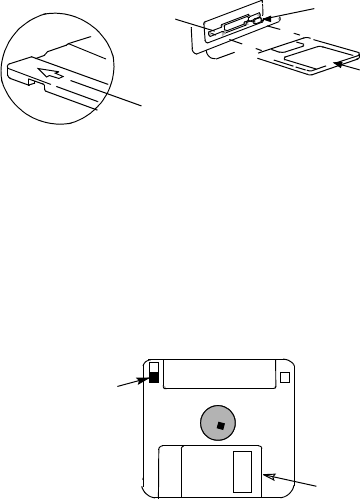
19
CAUTION: Do not use an abrasive cloth or volatile solvents to clean any
portion of the PRM.
The cables used with the PRM are not sterile when packaged. When nec-
essary, clean the cables with a soft cloth dampened with a mild cleaning
solution (e.g., Liqui-nox for the sterilizable telemetry wand; Borax or a
1:10 bleach solution for other cables). Using the same method, wipe them
completely with sterile water and towel- or air-dry. DO NOT use an ultra-
sonic cleaner NOR immerse the cables. Clean the sterilizable telem-
etry wand in the same manner, allowing no fluids to enter the wand
cavity. See “Prepare the Telemetry Wand” on page 6 for sterilization
instructions.
Patient Data Disk
The Model 6627 Patient Data Disk must be inserted with the arrow on the
top left side and pointing into the disk drive (Figure 9).
Figure 9. Disk drive on the right side of the PRM.
Be certain that the write-protect tab is closed on the disk (Figure 10). In-
sert a patient data disk firmly into the disk drive on the right side of the
PRM until the disk ejection button protrudes.
NOTE: For complete instructions on using the patient data disk, refer to
the System Guide for the Guidant pulse generator being interrogated.
Figure 10. Floppy disk (3.5 inch) with write-protect tab closed.
Caring for Disks
Floppy disks can be damaged easily, making them unusable. To prevent
damage to the disks:
• Write on labels before applying them to disks.
Arrow on top and pointing to
the disk drive
Disk Drive Disk Ejection Button
Patient Data Disk
Write-protect tab closed
(black tab covering hole)
Sliding Shutter
20
• Use only a felt-tipped pen to write on a label that is already applied to
a disk.
• Keep food and beverages away from disks and away from the PRM.
• Keep disks away from heat or direct sunlight. Disks should be stored
at temperatures between 5° and 60°C (41°–140°F).
• Keep disks dry and stored in a dry area (with a relative humidity be-
tween 8 percent and 80 percent).
• Do not bend disks.
• Do not attach paper clips, staples, or rubber bands to disks.
• Do not try to open the sliding shutter that covers the disks (Figure 10).
• Never touch the exposed disk area beneath the sliding shutter.
NOTE: The write-protect tab must be closed in order to record data to the
disk and to print reports. If data cannot be recorded to the disk, check to
see that the tab is positioned to cover the hole (Figure 10).
CAUTION: Keep disks away from magnets and magnetized objects, in-
cluding telephones, power supply adapters, and monitors.
Operation and Storage Conditions
The Model 3120 PRM requires careful handling. The hard-disk drive and
the floppy-disk drive must be protected from abusive handling. To protect
the PRM from damage:
• Do not turn off the PRM while the drive is accessing data.
• Do not subject the PRM to abusive shocks or vibrations.
• When transporting the PRM from a cold environment to a warm envi-
ronment, allow the PRM to warm to ambient temperature before use.
• Do not place heavy objects on the PRM surface when closed or when
in operation.
• Do not place a magnet on the PRM.
• Do not pour or splash liquid into or onto the PRM.
• Do not strike, scratch, nick or otherwise abuse the touchscreen sur-
face.
• Do not disassemble the PRM.
• Remove any disks from the drive prior to transporting the PRM.
• Turn off the PRM, close all covers and doors and put down the anten-
na prior to transporting the PRM.
• Unplug all external cables and cords prior to transporting the PRM.
Operate the PRM within a temperature range of 10° to 40°C and a humid-
ity between 20 and 95 percent. Transport and store the PRM at tempera-
tures between –40× and 70×C, humidity of 5–95 percent, and pressure of
500–1,060 hPa. If the PRM has been stored in cold conditions (less than
10°C), turn it on and let the fan run for at least one hour before use.

21
Safety and EMC Compliance Standards
This equipment has been tested and found to comply with applicable
safety portions of the following standards:
• EN60601-1:1990 + A1:1993 + A2:1995
• UL60601-1:2003
• CAN/CSA-C22.2 No. 601.1-M90
This equipment has been tested and found to comply with the limits for
medical devices to IEC 60601-1-2: 2001 [or EN 60601-1-2: 2001 or Med-
ical Device Directive 93/42/EEC]. This testing shows the device provides
reasonable protection against harmful interference in a typical medical in-
stallation. However, there is no guarantee that interference will not occur
in a particular installation. If this equipment does cause harmful interfer-
ence to other devices or is negatively impacted by other devices, the user
is encouraged to try to correct the interference by one or more of the fol-
lowing measures:
• Reorient or relocate the devices
• Increase the separation between the devices
• Connect the equipment to an outlet on a different circuit
• Consult the manufacturer or field service technician for help.
This equipment has been tested an and found to comply with the following
EMC standards:
FCC Part 15C
EN 300 330 -2 V 1.1
The PRM is capable of continuous operation and will not shut off automat-
ically if it is unused for an extended time or if it runs out of paper. Keep the
air intake and outlet free from obstruction.
CAUTION: The PRM is not water-proof or explosion-proof. It should not
be used in the presence of flammable gas mixtures including anes-
thetic mixture with air, oxygen, or nitrous oxide.
PRM Storage
1. If using a patient data disk, remove disk from the disk drive by
pressing the disk ejection button (Figure 9), and store the disk in a
safe place.
2. Exit the current software application.
3. Press the Power button to turn the power off (Figure 2).
NOTE: Before unplugging the power cord to move the PRM, always exit
the software application and press the Power button to turn off the PRM;
otherwise, your system may lock up completely or have boot errors.
22
4. Unplug the power cord from the wall.
5. Unplug the cables from the back and side panels and other equip-
ment.
6. Lower the screen until the front latch locks in place.
NOTE: The programmer is not intended to be rested or stored in an up-
right position (resting on rear panel with handle on top).
EXTERNAL CABLE CONNECTIONS
The following cables are required for use with the Model 3120 Program-
mer/ Recorder/Monitor when using the configurations described in this
section.
• Model 6924 External Recorder Cable: a six-channel DIN – six BNC
cables (color-coded and numbered) for connection of the PRM analog
output signals to another strip chart recorder or monitor.
• Model 6750 Surface ECG Patient Cable: a six-pin amphenol ECG ca-
ble for connecting the patient directly to the PRM.
• Model 6629 ECG-BNC Slave Cable: used for input of patient ECG sig-
nals to the PRM from an external monitor or recorder.
• Model 6577 Sterilizable Telemetry Wand.
The PRM also has two adapter kits that adapt cables with BNC connec-
tors to fit other sockets:
• Model 6930:BNC–dual banana plug
BNC–pin tip
BNC–alligator clip adapters
• Model 6934:BNC–phono adapter
Refer to Figure 11 for cable connections.
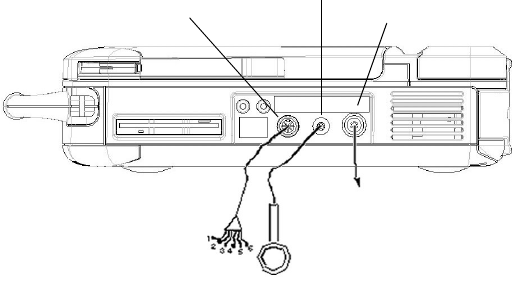
23
Figure 11. Cable connections for the Model 3120 PRM.
Surface ECG Connections
Three cable–electrode configurations frequently used to generate surface
ECGs include the following:
• Patient to external recorder to PRM (Figure 12)
• Patient to PRM to external recorder (Figure 13)
• Simultaneous connections from patient to PRM and patient to external
recorder (Figure 14)
NOTE: Annotated event markers cannot be sent to an external recorder.
Patient ECG Cable or
ECG BNC Slave Cable
External Recorder Cable:
Channel 1 (red) - surface ECG
Channel 2 (orange) - telemetered signal 1
Channel 3 (green) - telemetered signal 2
Channels 4, 5, 6 - not active
Telemetry Wand Connector
Analog Output Channel ECG Connector
Telemetry Wand
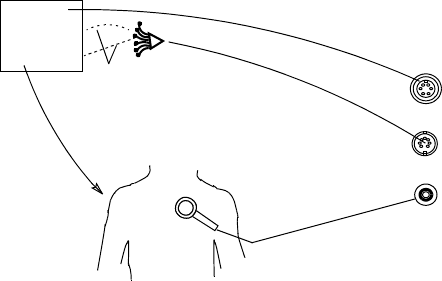
24
Patient–Recorder–PRM Connection
To display a tracing on an external recorder and the PRM without using
the patient ECG cable, set up equipment as shown in Figure 12.
Figure 12. External recorder gets surface signal and sends it to the PRM.
PRM sends electrograms to the external recorder.
1. Connect the external recorder’s patient ECG leads to the appropri-
ate electrodes.
2. Route the surface ECG channel to the PRM using the ECG–BNC
slave cable. (Use the Model 6930 or 6934 adapter cables, if neces-
sary.)
3. Connect the orange and green connectors of the external recorder
cable to the external recorder for telemetered signals.
4. Adjust gain and filters on the external recorder.
5. Connect the telemetry wand and verify proper position. Make sure
the wand cord does not cross other cables.
Setup is now complete.
PATIENT > RECORDER > PRM
Tele m et r y Wa nd
Patient ECG
Cable
External Recorder
ECG-BNC Slave Cable
External Recorder
Cable
PRM
Connectors
ECG
IN
Wand
IN
Analog
OUT
Surface IN
Surface
OUT
Channels 2 and 3
(orange and green)
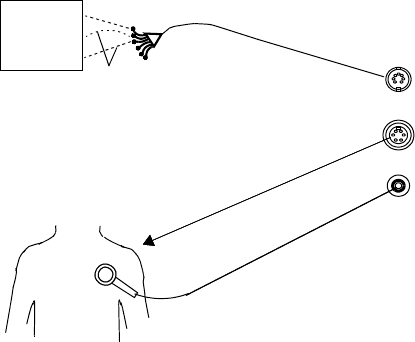
25
Patient–PRM–Recorder Connection
To display a tracing on the PRM and an external strip chart recorder using
the patient ECG cables, set up equipment as shown in Figure 13.
Figure 13. PRM receives surface signal via the patient cable and then sends
surface and telemetered channels to the external strip chart recorder.
1. Connect the external recorder cable from the PRM to the external
recorder input ports.
• Channel 1 (red) for a surface trace
• Channel 2 (orange) for telemetered signal 1
• Channel 3 (green) for telemetered signal 2
2. Connect the patient ECG cable to the patient electrodes.
3. Verify proper telemetry wand position.
Setup is now complete.
Telemetry Wand
Patient ECG
Cable
External Recorder
External Recorder
Cable
PATIENT > PRM > RECORDER
Channel 1 (red)
PRM
Connectors
ECG
IN
Wand
IN
Analog
OUT
Surface
IN
Channels 2 and 3
(orange and green)
Patient ECG
Cable
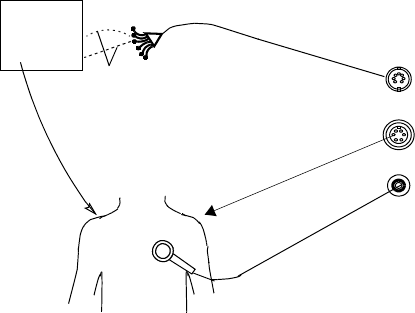
26
Parallel Connection
To display traces on both PRM and ECG recorders using two different pa-
tient ECG leads, set up the equipment as shown in Figure 14.
Figure 14. Parallel connection of PRM surface leads and external surface
monitor.
1. Connect the external recorder patient ECG leads to the appropriate
limb electrodes.
2. Connect the patient ECG cable to the patient electrode.
3. Connect the external recorder cable from the PRM to the external re-
corder.
NOTE: This configuration will add the most noise to the tracings of the
two PRM–recorder configurations.
4. Adjust gain and filters on the external recorder.
Setup is now complete.
NOTE: The right leg electrode conductor on the patient ECG cable is a
driven ground. When connecting the PRM and an external ECG monitor
in parallel, the driven grounds for the two instruments must be connected
to the same patient limb (e.g. right leg electrode); otherwise, noise prob-
lems will occur.
Telemetry Wand
Patient ECG
Cable
External Recorder
External Recorder
Cable
PRM
Connectors
ECG
IN
Wand
IN
Analog
OUT
Surface
IN
Patient ECG
Cable
PATIENT > RECORDER
PATIENT > PRM
Channels 2 and 3
(orange and green)

27
TROUBLESHOOTING
If the PRM does not operate properly, check that electrical cords and ca-
bles are securely connected and that cords and cables are in good work-
ing order (i.e., free of visible defects). Table 2 indicates possible causes
and corrective actions for PRM problems. For external printer problems,
refer to the manual for the external printer.
Table 2. Possible Causes and Corrective Actions for PRM Problems
Symptom Possible Cause Corrective Action
Internal printer/
recorder does
not function
No AC line voltage
Check that power cord is
plugged securely into the rear
panel of the PRM.
Change to a different electrical
outlet.
Paper jam Clear paper path of any
obstruction.
Internal printer/
recorder: paper-
feed problems
Paper
misaligned Reload paper.
Paper-feed
obstruction
Clear obstruction from around
the paper supply.
Internal printer/
recorder: no
print visible
Paper loaded upside
down
Reload paper. (See “Loading
the Paper” on page 17.)
No analog
output
Using incorrect output
port and/or
connections
Recheck connection of the
Model 6924 External Recorder
Cable.
Patient data disk
error
Using disk created for a
previous model of PRM
or unformatted floppy
disk
Use only Guidant Model 6627
Patient Data Disks.
Write-protect tab open Close write-protect tab.
Noise problems:
ECG
Improper patient
connections
Recheck patient leads for
adequate skin contact and
correct limb lead placement.
“Noisy” equipment
Check surrounding area for
equipment with excessive radio
frequency emissions. Move
unneeded equipment away
from patient and/or PRM, or
turn off unneeded equipment.
Consult ECG textbooks for
additional ECG techniques.
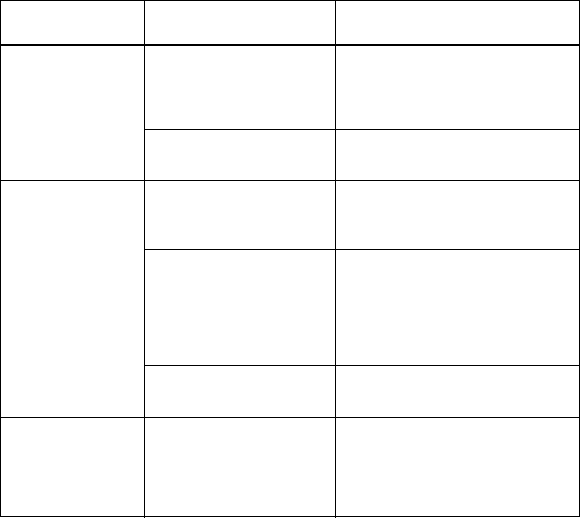
28
Telemetry: no
communication
Incorrect application
software or incorrect
PRM for pulse
generator
Install proper application
software for pulse generator in
use.
Incomplete telemetry
communication
Reposition wand over the
device; repeat interrogation.
Te l em e tr y:
intermittent
communication
Incorrect telemetry
wand
Use only the Guidant
Model 6577 Sterilizable
Telemetry Wand.
“Noisy” equipment
Check surrounding area for
equipment with excessive radio
frequency emissions. Move
unneeded equipment away
from patient and/or PRM, or
turn off unneeded equipment.
Incomplete telemetry
communication
Reposition wand over the
device; repeat interrogation.
Displayed clock
does not
consistently
keep time after
setting
Low battery Return to Guidant for
replacement of clock battery.
Table 2. Possible Causes and Corrective Actions for PRM Problems
Symptom Possible Cause Corrective Action
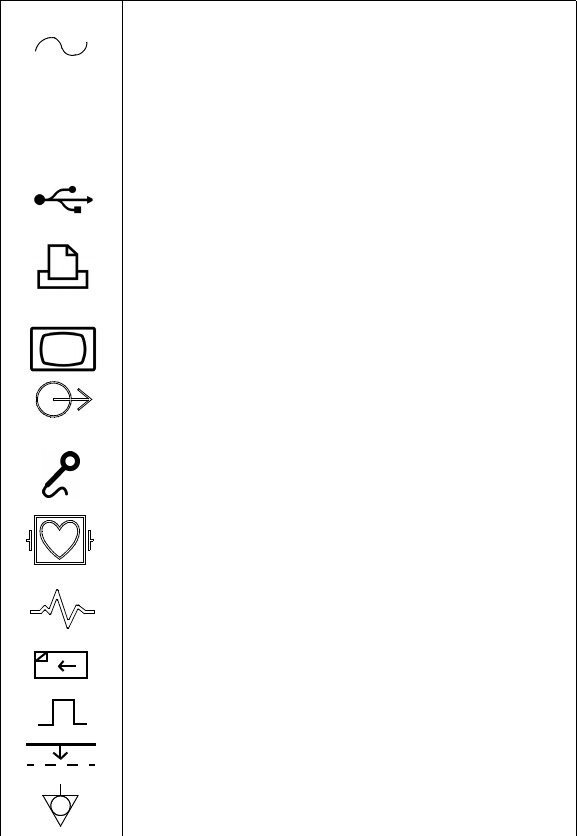
29
LABEL SYMBOLS
Table 3 illustrates the symbols used on the Model 3120 PRM and in-
cludes an explanation of each symbol.
Table 3. Label Symbols and Their Meanings
Symbol Meaning
Alternating current
Need
graphic.
Power button: <<<DECISION PENDING WITH TUV>>>
USB
Parallel connector for printer
VGA output for external monitor
Analog output
Telemetry wand input
Indicates defibrillator-proof CF-type patient
ECG cable connector
Paper form feed
Calibration pulse
Bring trace to baseline
Indicates the potential equalization conductor. This
connection allows a common ground with other equipment in
a clinical setting.
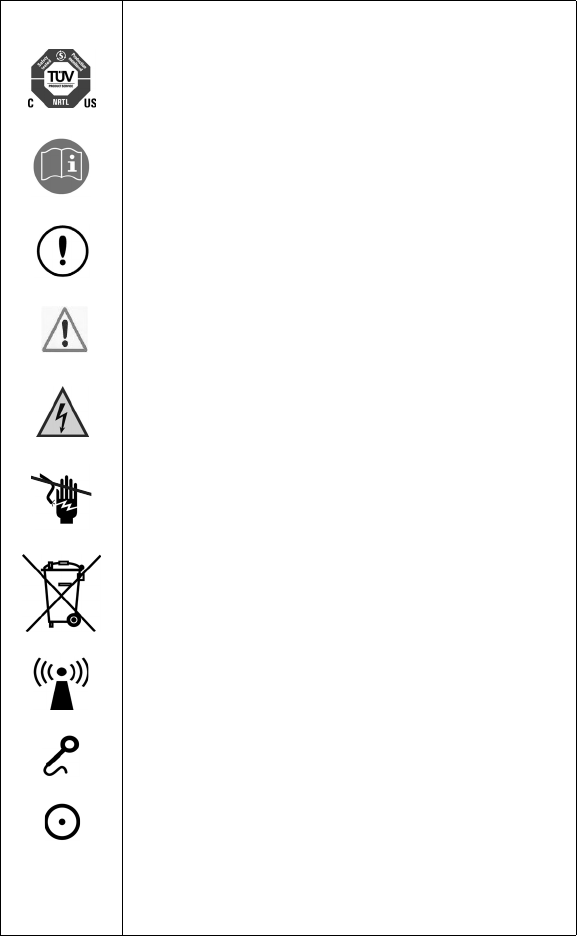
30
Mark for nationally recognized testing for safety standards.
See instruction manual.
Radio, Telecommunications and Terminal Equipment (RTTE)
symbol. Indicates that device does not operate in a
harmonized bandwidth.
General warning.
Dangerous voltage. Refer servicing to Guidant.
Indicates the risk of electric shock; do not remove the cover
(or back). Refer servicing to Guidant.
Indicates separate collection for electrical and electronic
equipment (i.e., do not throw this device in the trash).
For future use.
Inductive telemetry indicator light
On indicator light
VVoltage
S/N Serial number
Table 3. Label Symbols and Their Meanings
Symbol Meaning
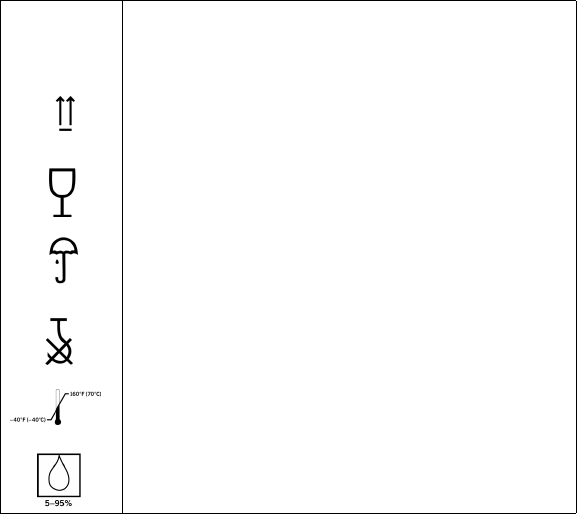
31
A/N Assembly number
This side up
Fragile, handle with care
Keep dry
Do not use hooks
Temperature limitations
Humidity limitations
Table 3. Label Symbols and Their Meanings
Symbol Meaning
32
WARRANTY INFORMATION
A limited one-year warranty and a warranty registration card for the
Guidant PRM is packaged with the PRM. Unless otherwise agreed, the
PRM remains the property of Guidant and Guidant must perform all nec-
essary servicing and repair work.
ORDERING ACCESSORIES
To order accessories, contact the nearest Guidant sales representative or
contact Guidant Corporation at the address or phone number on the back
cover of this manual.
SERVICE
For questions regarding operation or repair of the PRM, call the nearest
Guidant representative or call Guidant Technical Services at the phone
number on the back cover of this manual. The PRM must be serviced by
Guidant personnel only.
If the Guidant PRM malfunctions and requires repair, help to ensure effi-
cient service by following these guidelines:
1. Leave the configuration of the instrument exactly as it was at the
time of malfunction. Contact the nearest Guidant representative or
call Guidant Technical Services at the phone number on the back
cover of this manual.
2. Write a detailed description of the malfunction(s).
3. Save printouts or other materials that illustrate the problem.
4. If the PRM must be returned to Guidant for service, pack it in the ship-
ping container in which it was received or in a shipping container pro-
vided by Guidant.
5. Send the PRM to Guidant at the address on the back cover of this
manual.
For problems or questions that arise regarding operation or repair of the
optional external printer, contact the printer manufacturer or agent.
PREVENTIVE MAINTENANCE
No preventive maintenance is needed by the user or service personnel.
ENVIRONMENTAL PROTECTION
Return the programmer to Guidant af the end of its useful life for appro-
priate disposal.
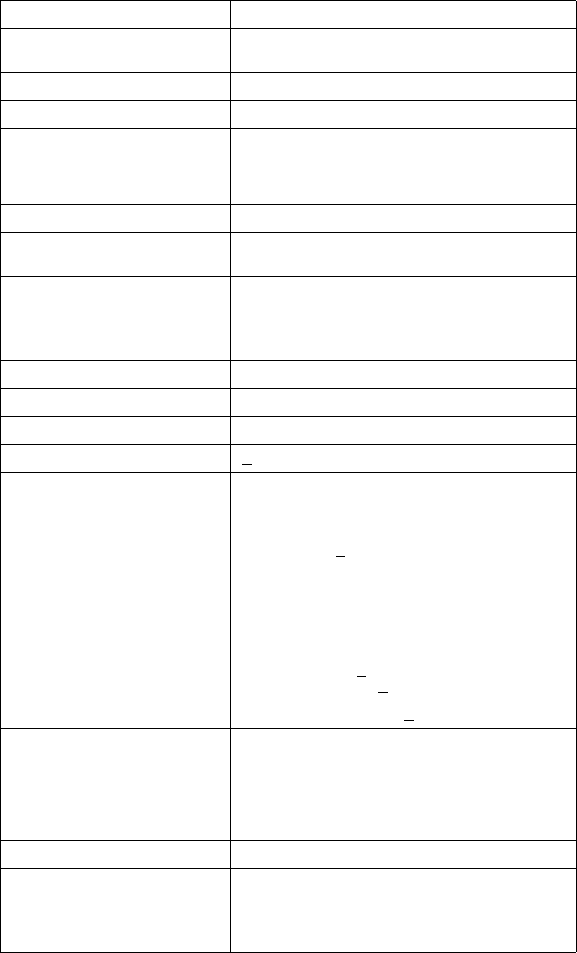
33
SPECIFICATIONS (Nominal)
Safety classification Class I, Type CF, Defibrillation protected
Dimensions 19 in (48.3 cm) deep, 14.5 in (36.8 cm) wide,
4.75 in (12.1) cm high
Weight (approximate) 21.5 lb (9.8 kg)
Power rating 100–120/200–240 V and 50–60 Hz 3.8/1.9 A
Power cord
8 ft. 100–240 V. Reliable grounding is
achieved only when equipment is connected
to receptacle marked with “Hospital only” or
“Hospital grade.”
Operating temperature 50–105°F (10–40°C)
Transport and storage
temperature –40 to 160°F (–40 to 70°C)
Relative humidity
• Transport and storage 5–95%
• Operating 20–95%
Atmospheric pressure 500–1,060 hPa
External printer support DB 25 parallel port connector
External monitor support DB 15 VGA port connector
Analog output + 1 V output via seven-pin DIN connector
ECG performance
• Lead selection I, II, III, aVR, aVL, aVF, V
• Intrinsic ventricular rate
display 30–240 bpm + 6 bpm
• Input impedance > 2.5 M Ω
• Electrode offset tolerance 300 mV
• Storage resolution 800 samples/sec, 4.56 µV
• Filter settings ON: 0.5–25 Hz, + 0.2 dB;
OFF: 0.05–100 Hz + 0.2 dB
• Gain settings 1, 2, 5, 10, 20 mm/mV + 25%
Internal printer
• Paper type Thermo-sensitive
• Paper width 4 in (110 mm)
• Chart speed 10, 25, 50, 100 mm/sec
Battery type DL 2450 or equivalent
Safety features
• Leakage current < 10 µA (patient); < 100 µA (chassis)
• Defibrillator protection to 5,000 V, 400 J
34

Guidant Corporation
4100 Hamline Avenue North St. Paul, MN 55112-5798 USA
24-Hour Consultation
1-800-CARDIAC (227-3422)
Worldwide: +1.651.582.4000
www.guidant.com
© 2004 Guidant Corporation
All rights reserved. 357043-001 A US 07/04